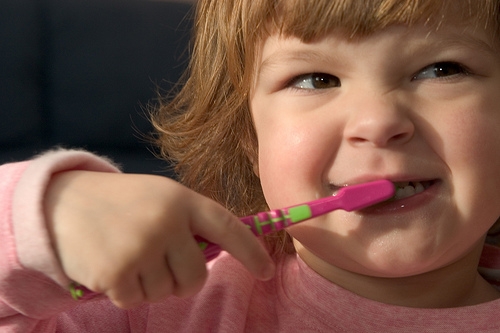October 12th, 2022

The primary teeth are the initial teeth that erupt from a child’s gums in the first few years of childhood. There are a total of 20 primary teeth, most of which will have appeared no later than age three. Because they are only temporary, some parents believe they are less important than the permanent teeth that will emerge around age five or six. However, primary teeth hold a special significance and are important for a child’s long-term oral health.
Function and importance of baby teeth
Baby teeth have several basic functions. Decay can interfere with these functions, and potentially lead to life-long complications. For example, severe tooth decay that causes tooth loss during childhood, perhaps due to sleeping with a bottle at night, can obstruct a child’s speech development. It can also hinder his or her ability to sufficiently chew food.
The primary teeth also serve as place-holders for the permanent teeth. When a primary tooth falls out or must be removed before its time, surrounding teeth may shift into the space the tooth once held. This can cause orthodontic complications once the permanent teeth begin to erupt, which can lead to serious tooth alignment problems and call for extensive orthodontic treatment.
Caring for baby teeth
Dr. Jennifer Wells and Dr. Erik Wells and our team at Healthy Smiles will tell you it is never too early to begin caring for your child’s teeth. Baby teeth require the same care and attention that permanent teeth do. The American Dental Association recommends that children see a dentist as soon as the teeth begin to erupt from the gums. Early childhood dental visits usually include examinations, cleanings, fluoride treatments, and hygiene education for parents. It is also important to adopt an oral care routine at home that includes daily brushing, flossing, and dietary modifications that support a lifetime of good oral health.
To learn more about baby teeh, or to schedule an appointment with Dr. Jennifer Wells and Dr. Erik Wells for your little one, please give us a call at our convenient Watkinsville office!
October 5th, 2022

How better to spend the fall months than inside by the fireplace with a warm cup of cider and a book in hand? Dr. Jennifer Wells and Dr. Erik Wells and our team at Healthy Smiles encourage you to warm up your mind this fall season with a few great books. Sure it may be easy to put off reading when balancing a hectic schedule, but reading is vital to brain development. Besides, reading is always a blast!
This week, we thought we’d ask what you or your child are reading this fall. Do you have any suggestions for must-read books this year? Out of ideas for great fall reads? Ask us for suggestions, and we would be happy to provide a few. You may also ask a local librarian here in Watkinsville for some ideas.
Happy reading! Be sure to share with us your fall picks or your all-time favorites below or on our Facebook page!
September 28th, 2022

“But they are only baby teeth; won’t they just fall out?” Our team at Healthy Smiles has had these questions asked many times from parents over the years. Primary teeth, or “baby teeth,” will indeed come out eventually, to be replaced by permanent teeth as the child grows and develops. These teeth serve a great purpose as the child continues to develop and require specific care.
Because baby teeth are temporary, some parents are unenthusiastic about fixing cavities in them. This may be due to the cost or having to force a child undergo the process—especially having to receive an injection. But if a cavity is diagnosed early enough, an injection can often be avoided. More important, failure to fill cavities in primary teeth when they are small and manageable can have lasting consequences in cost and health concerns. Serious illnesses in children have been diagnosed which began as a cavity.
Primary teeth act as a guide for permanent teeth. When decay reaches the nerve and blood supply of a tooth, this can cause an abscess. Severe pain and swelling may result. At that point, the only treatment options are either to remove the tooth or to perform a procedure similar to a baby root canal. When a primary tooth is lost prematurely—to decay or a painful abscess—the adjacent teeth will often shift and block the eruption of a permanent tooth. Braces or spacers become necessary to avoid crowding or impaction of the permanent tooth.
There is nothing more heartbreaking for Dr. Jennifer Wells and Dr. Erik Wells than to have to treat a child experiencing pain and fear. To all the parents of my little patients our team strongly recommend filling a small cavity and not waiting until it becomes a larger problem such as those described above.
Prevention is the key to a healthy mouth for our smallest patients. Parents should allow the child to brush his or her teeth using a pea-sized amount of fluoride toothpaste and then take a turn to ensure the plaque gets removed from all surfaces: cheek side, tongue side, and chewing edges of all the teeth.
September 21st, 2022

When a child is born, he or she will have 20 primary teeth and 32 permanent teeth. But sometimes kids are born with additional teeth, and our team at Healthy Smiles calls this oral condition "hyperdontia." Primary teeth are the first set of teeth that erupt in your child's mouth, typically by the time they are 36 months old, and are shed by the time your child reaches the age of 12. Permanent teeth then take the place of the primary teeth and are usually fully-erupted by the time your son or daughter reaches 21 years of age. Anyone who develops more than 20 primary teeth or more than 32 permanent teeth has hyperdontia, and the additional teeth are referred to as supernumerary teeth.
While the cause of hyperdontia is not entirely clear, it is believed that there may be a genetic factor. Oral professionals have found that patients with extra teeth often have syndromes like cleidocranial dysplasia, Ehler-Danlos syndrome, Gardner syndrome, or cleft lip and palate. The prevalence of hyperdontia affects between one and four percent of the population in the United States, and the majority of cases are limited to a single tooth.
So, what is the best way to deal with hyperdontia? It really depends on the case. The treatment plan your doctor suggests varies according to the potential problem posed by the supernumerary teeth, as well as their type. Orthodontic treatment may certainly may help, but extraction can also be a good option. We recommend that children receive an oral evaluation or checkup no later than the age of seven. In addition to hygiene evaluation, this helps ensure your child does not experience hyperdontia problems.
If you suspect you or your child may be suffering from hyperdontia, please give us a call to schedule an appointment at our convenient Watkinsville office to be evaluated.




